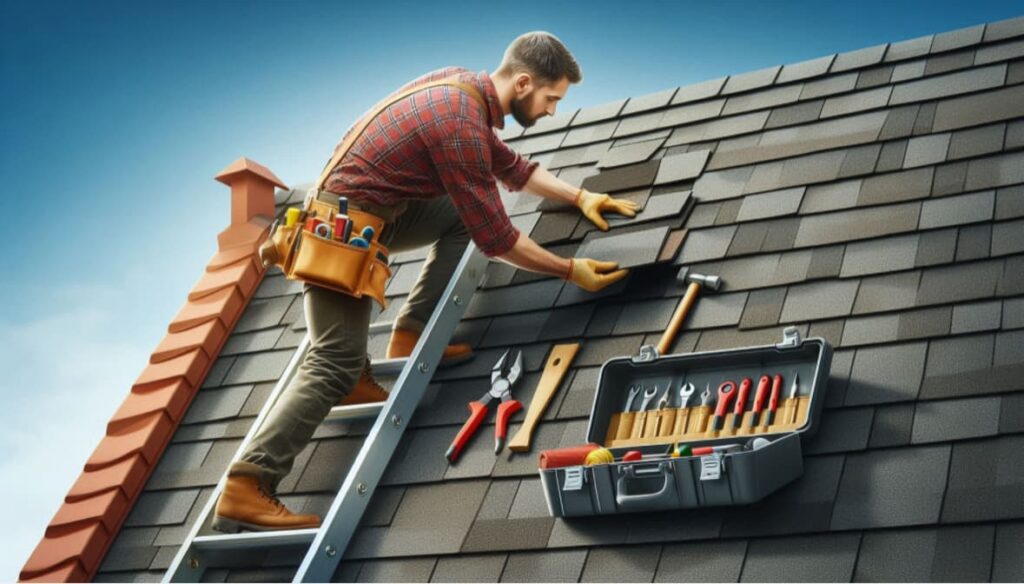Shingles
Roof Shingles Repair: Made Easy
Keeping your roof in great shape is essential to protecting your home. Roof shingles repair is one of the most critical aspects of home maintenance. Whether it’s fixing curled shingles or replacing missing ones, addressing these issues early saves money and prevents further damage.
In this guide, we’ll walk you through everything you need to know about repairing roof shingles while keeping things simple and actionable.
1. Introduction
Roof shingles are your home’s first defense against the elements. Small issues, like damaged or missing shingles, can quickly lead to expensive problems if ignored.
Timely roof shingles repair not only saves you money but also keeps your home secure. This guide will help you spot damage, decide between DIY and professional fixes, and take effective steps to keep your roof in top condition.
If you’re ready to take action, check out this expert roofing service to get started.
2. Common Types of Roof Shingle Damage
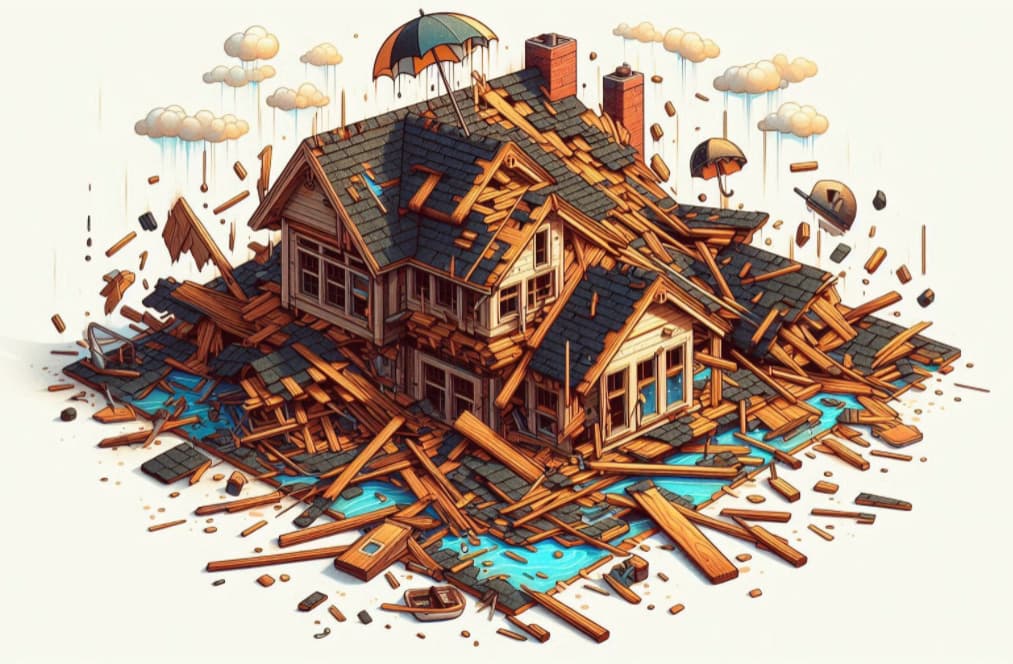
Roof shingles are designed to withstand harsh weather conditions, but they are not immune to wear and tear over time. Identifying the types of damage early can help you address issues before they escalate into costly repairs.
Let’s dive deeper into the common types of roof shingle damage:
1. Blistering
- Blistering occurs when moisture gets trapped within the shingles or when the roof is exposed to excessive heat. This causes small, raised spots to form on the surface of the shingles.
Over time, these blisters may pop, leaving your shingles vulnerable to further damage, such as cracking or leaks.
Blistering is often seen on roofs in areas with high humidity or fluctuating temperatures. Regular inspections can help catch this problem early before it worsens.
2. Cracking
- Cracking is one of the most noticeable signs of aging or weather-related stress on roof shingles. Prolonged exposure to the sun, wind, and rain weakens the shingles’ structure, causing them to split or crack.
These cracks can allow water to seep into the roof, leading to potential leaks or even damage to the underlying structure.
Minor cracks can sometimes be repaired with sealant, but widespread cracking often indicates the need for replacement.
3. Curling
- Curling is a common issue in older roofs or those with improperly installed shingles. The edges of the shingles begin to lift and curl upwards, reducing their ability to form a tight seal against the elements.
Curling shingles are more prone to being blown off during storms or allowing water to penetrate. Causes of curling include aging, excessive moisture, or inadequate ventilation in the attic.
Addressing curled shingles promptly with proper repair techniques can extend your roof’s life.
4. Missing Granules
- Granules are the small, pebble-like particles that coat the surface of asphalt shingles. They play a vital role in protecting shingles from UV rays and reducing the impact of weathering.
Over time, these granules may fall off due to aging, hail, or debris hitting the roof. Shingles with missing granules appear bare or smooth in patches, making them more susceptible to sun damage and deterioration.
If you notice granules collecting in your gutters, it’s time to inspect your roof.
5. Wind Damage
- High winds can be especially destructive to roof shingles. They can lift the edges of shingles, weaken their attachment, or completely tear them off.
Missing shingles leave the roof’s underlayment exposed to rain, snow, and debris, increasing the risk of leaks and structural damage.
Roofs in areas prone to strong winds or storms are particularly vulnerable, so it’s important to secure any loose shingles before bad weather strikes.
Why Regular Inspections Matter
- Each of these damages may seem minor at first, but if left unaddressed, they can lead to costly repairs or even the need for a full roof replacement.
Inspecting your roof twice a year, ideally in the spring and fall, is a proactive way to catch these issues early. During your inspection, look for bald spots, curling edges, cracks, or missing shingles.
For peace of mind and professional evaluation, you can consult a trusted roofing expert.
Regular maintenance can save you time and money while keeping your roof in optimal condition. Check out this expert roofing service to ensure your roof gets the care it deserves.
3. Tools and Materials for Shingle Repairs
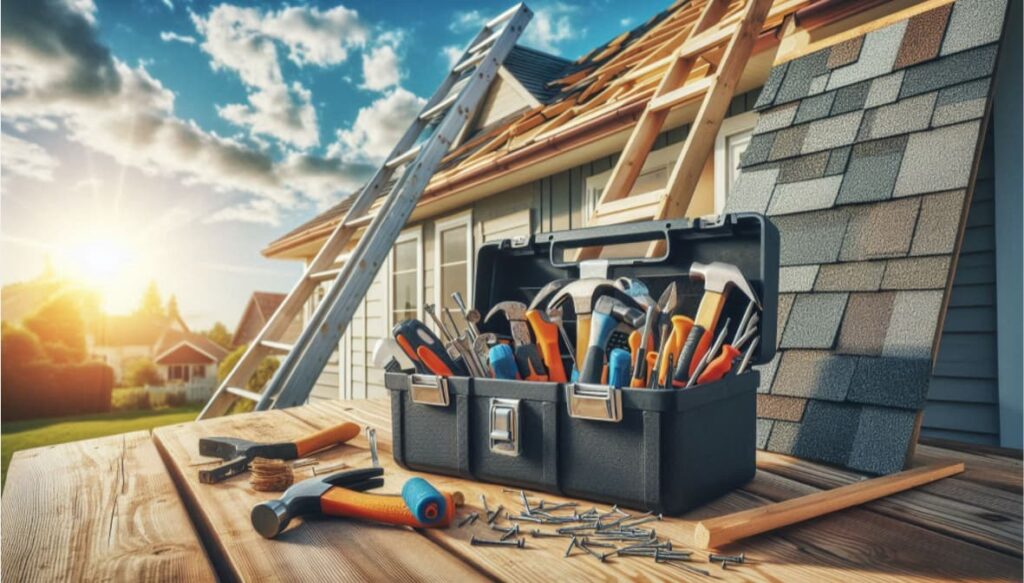
Before starting your roof shingles repair, gather the right tools:
- Hammer
- Roofing nails (1¼ inch)
- Flat pry bar
- Roofing cement
- Replacement shingles
- Roofing sealant
- Utility knife
Safety is crucial. Use gloves, stable ladders, and non-slip shoes to reduce risks. If unsure, seek guidance from trusted experts like Absolute Perfection Roofing. They’ll ensure professional-grade materials and safety throughout the process.
4. DIY Shingle Repair Techniques
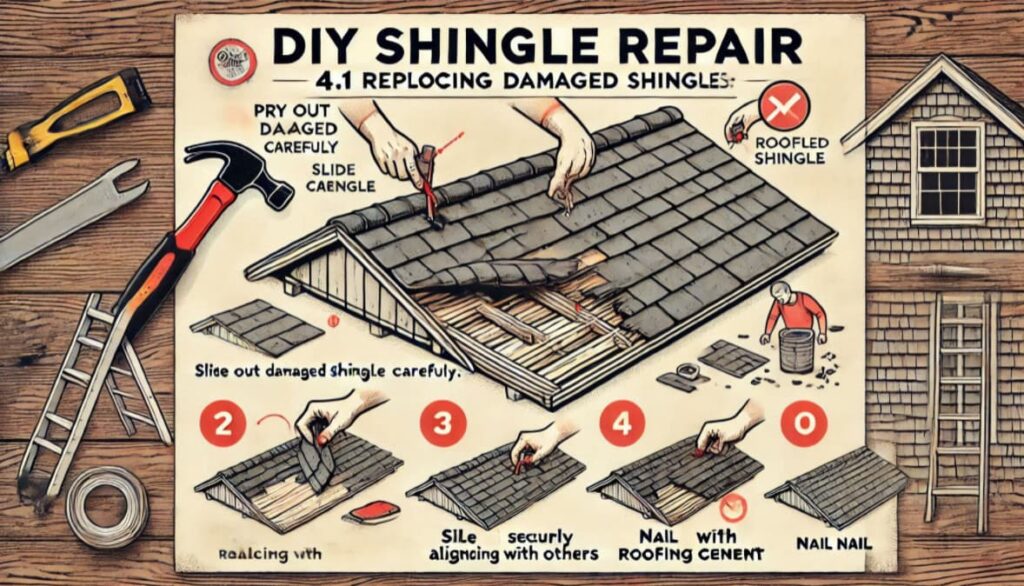
4.1 Replacing Damaged Shingles
To replace damaged shingles:
- Pry out the damaged shingle carefully.
- Slide a new shingle into place, aligning it with others.
- Nail it securely and seal with roofing cement.
Replacing shingles not only protects your roof but adds years to its lifespan. For long-lasting results, explore quality materials through this roofing link.
4.2 Fixing Curled Shingles
Fixing curled shingles is straightforward:
- Apply roofing sealant under the curl.
- Press firmly and weigh down with a brick.
- Allow it to dry for 24 hours.
4.3 Repairing Cracked Shingles
Cracks can be repaired using roofing sealant:
- Apply sealant under and over the crack.
- Press the shingle firmly.
- Sprinkle granules over the wet sealant for a seamless look.
5. When To Call a Professional
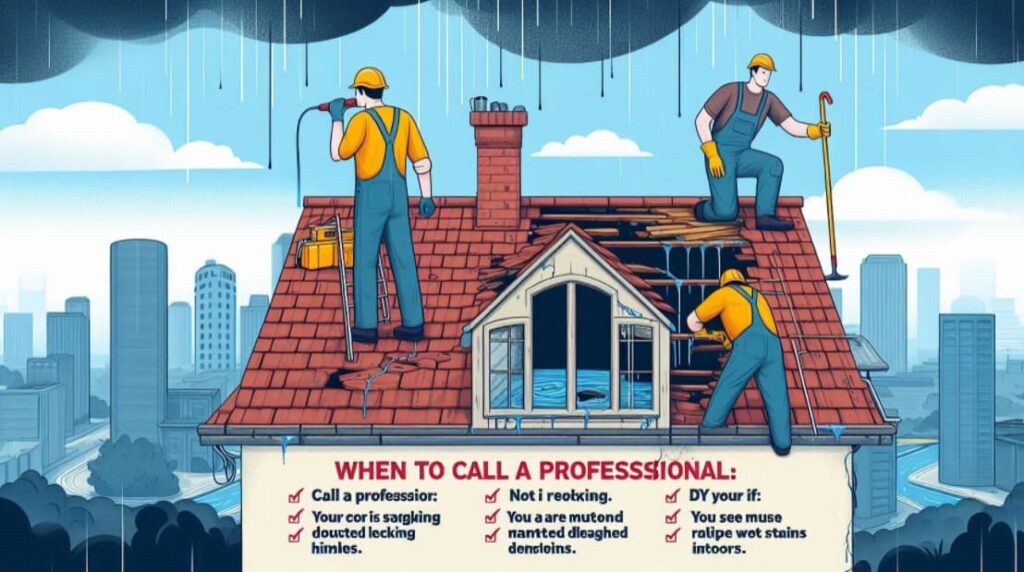
Not all repairs are DIY-friendly. Call a professional if:
- Your roof is sagging or leaking.
- There are multiple damaged shingles.
- You see water stains indoors.
Professional repairs provide lasting solutions and warranties. Schedule an inspection today with Absolute Perfection Roofing.
6. Preventative Maintenance for Roof Shingles
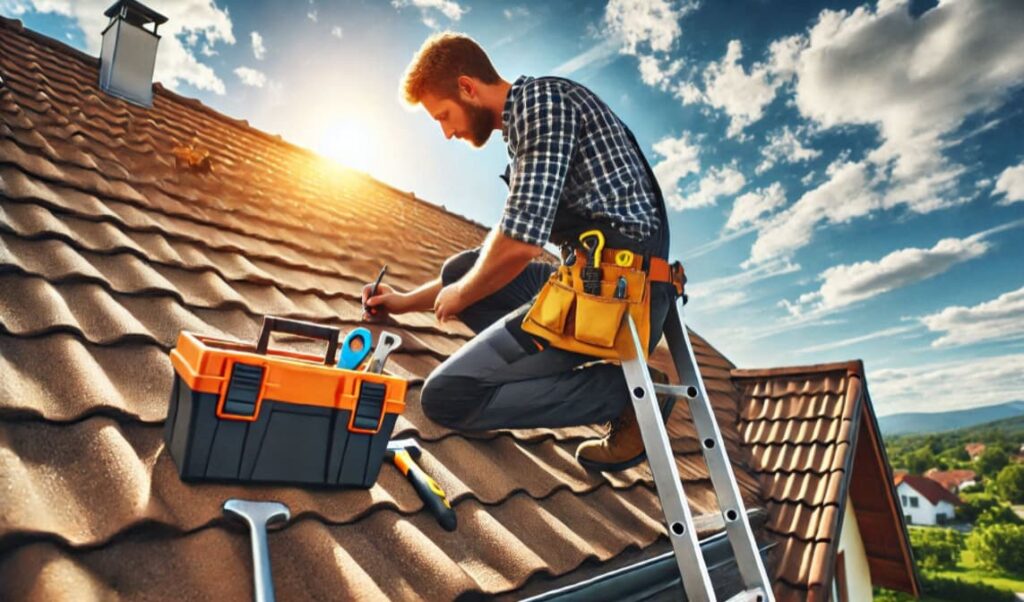
6.1 Regular Inspections
Check your roof every spring and fall. Look for damaged shingles, blocked gutters, and debris buildup. Identifying issues early avoids costly repairs.
6.2 Seasonal Tips
- Winter: Remove snow to prevent ice dams.
- Summer: Inspect for UV damage.
Professionals can help with detailed inspections. Secure a trusted partner through this roofing service.
7. The Cost and Longevity of Roof Shingles

Understanding the cost and lifespan of roof shingles is crucial for budgeting repairs or replacements and planning for long-term maintenance.
While shingles are an affordable roofing option compared to other materials, their cost and longevity depend on several factors.
Let’s break it down.
7.1. Typical Cost of Roof Shingles
The cost of shingles varies depending on the type, quality, and brand. Here’s a general price range:
- Asphalt Shingles: The most common and affordable option, ranging from $100 to $150 per square (100 square feet).
- Architectural Shingles: A higher-end version of asphalt shingles, costing $250 to $300 per square.
- Metal Shingles: Durable and stylish but more expensive, priced between $300 and $600 per square.
- Wood Shingles: Offering a natural look, wood shingles cost around $350 to $450 per square.
- Slate Shingles: The premium choice, with prices starting at $1,000 per square.
Keep in mind that labor, disposal fees, and additional materials, such as underlayment and flashing, can significantly increase the overall cost.
7.2. Lifespan of Roof Shingles
The longevity of roof shingles depends on the material and external factors. Here’s how long you can expect different shingles to last:
- Asphalt Shingles: 15–30 years.
- Architectural Shingles: 25–50 years.
- Metal Shingles: 40–70 years.
- Wood Shingles: 20–30 years with proper maintenance.
- Slate Shingles: 75–100 years or more.
While asphalt shingles are cost-effective, premium options like metal or slate offer extended durability, making them a better investment for homeowners seeking longevity.
7.3. Factors That Influence Shingle Lifespan
Several factors affect how long your shingles will last:
- Climate: Harsh weather conditions, such as extreme heat, heavy rain, snow, or high winds, can shorten a roof’s lifespan.
- Installation Quality: Poor installation can lead to premature wear and tear. Always hire experienced professionals for installation.
- Maintenance: Regular inspections and timely repairs prevent small issues from escalating into significant damage.
- Roof Ventilation: Proper ventilation in the attic reduces moisture buildup, which can deteriorate shingles over time.
7.4. Balancing Cost and Durability
When choosing shingles, it’s essential to balance initial cost with long-term value. While asphalt shingles are budget-friendly, investing in higher-quality options like architectural or metal shingles can save you money in the long run by reducing the frequency of replacements.
If you’re considering replacing your roof or upgrading your shingles, reach out to Absolute Perfection Roofing. They offer expert advice and quality services to ensure your investment pays off.
7.5. Pro Tip: Plan for Replacement
Regular roof inspections help you gauge when a full replacement is necessary. If your roof is over 20 years old and shows widespread damage, it’s likely time for new shingles. Factor in material costs, labor, and additional expenses to avoid surprises.
Asphalt shingles typically last 15–30 years. Factors like weather, installation quality, and maintenance affect their lifespan. Regular roof shingles repair ensures you get the most out of your roof. Need advice? Reach out to experts here.
Final Thoughts on Roof Shingles Repair
Roof shingles repair is crucial for protecting your home and saving money. With regular maintenance and timely fixes, you can avoid significant damage. Whether you tackle repairs yourself or hire a pro, keeping your roof in top shape is worth the effort.
Have you checked your roof recently? Let us know in the comments, share this guide with friends, and like the article to spread helpful tips!
Recent Posts
- Metal Roof Shingles: Durable, Stylish, and Ready for You!
- How to Install Metal Roofing Over Shingles: Save Big Now!
- What is a Square in Roofing? The Basics of Roofing Measurements
- Roof Condensation Solutions: Effective Fixes for a Safer Home
- Roofing and Cladding Essentials – Don’t Miss Out!

